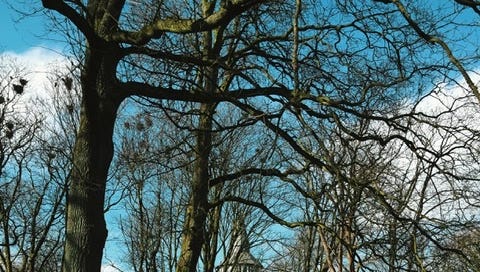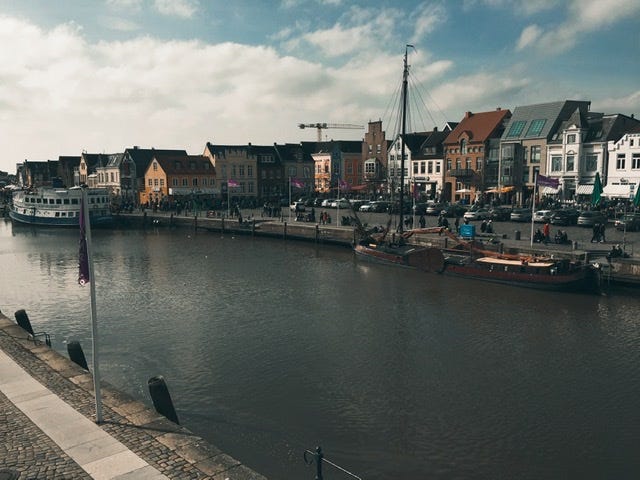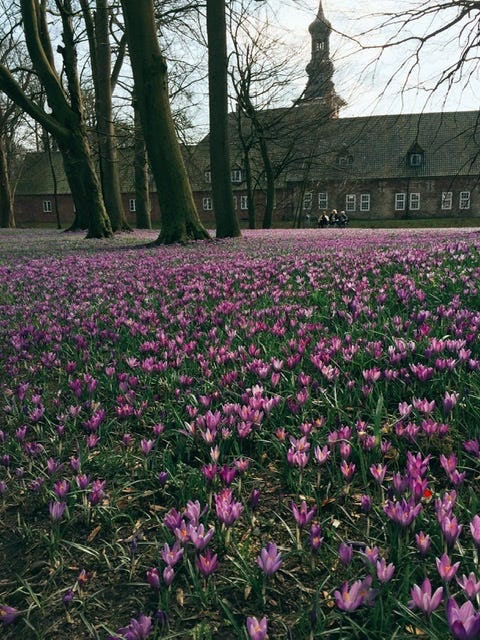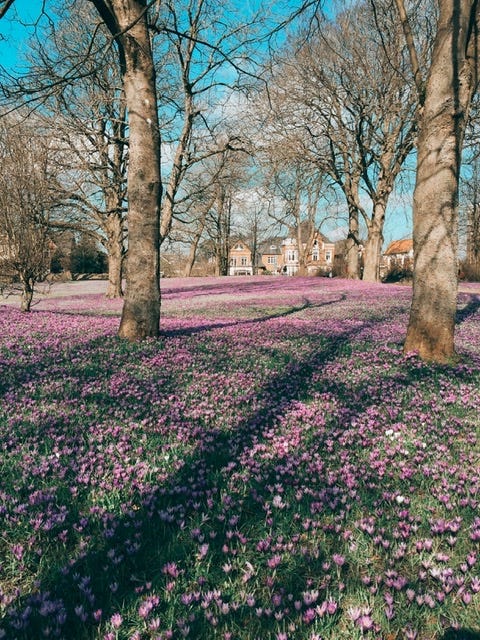Husum, or, as the novelist Theodor Storm called it, “the grey town by the sea” is like any other Northern German coastal town: neat, quaint, somewhat sleepy. Every early spring, however, its castle grounds showcases the outcome of the most endearing misunderstanding in European Medieval history: 5 million purple crocuses in bloom. An excursion.
The sky over North Frisia is so vast, the horizon of the nearly treeless fallow so distant and flat, that one cannot help but feel tiny. The hamlets dispersed on this flatland have ancient and whimsical names, bearing witness to ethnic Frisian and Danish influence over the centuries. I do not know this land and I am in awe. A persistent wind sweeps the plains and the car’s altimeter registers 0 meters “above” sea level, then -5 meters, then -10; the land and the sea licking the shore somewhere nearby could become one in an instant. The thought of an imminent flood casts a shadow over my sense of security and stays with me, as it had stayed with the Frisians and Germans inhabiting this land.
Life here used to be an ongoing battle against the monstrous waves crashing over the mudflat of the Wattenmeer. In a stubborn effort to claim the arable land and protect it from wind and sea, locals erected and re-erected dikes for hundreds of years, lost islands, livelihoods to raging storm tides, began again.
Husum, the quaint coastal capital of the Nordfriesland district hadn’t always enjoyed direct access to the sea: it was a town originally located further inland. And then Saint Marcellus’ flood came on the eve of 16th January 1362. The flood is called Grote Mandrenke in Low Saxon, the Great Drowning of Men, as the storm tide claimed 25,000 lives and tore the Frisian coast apart. It drowned islands, created new ones, wiped out towns, and tore into the town of Husum—the result is the Marina (Binnenhafen), a natural port that elevated the settlement to the rank of a bustling market town.
Within a decade Husum outgrew its modest walls, and the next phase of growth saw the arrival of the Greyfriars, who built their monastery further away from the town center and set up their remarkably self-sufficient modus operandi. Legend has it, that it was their brilliant business idea to plant crocuses in the hopes of harvesting saffron—they probably tried to replicate the success of their English contemporaries, as Essex had become the epicenter of saffron production in the 15th century. To compete with and eventually subdue them would have meant an unparalleled economic and political position in Northern Europe: independence from Silk Road merchants and a steady influx of gold. It all made perfect sense. Everyone in Europe craved saffron.
The uses of the deep reddish gold strands were various and its usage did not merely signify high social standing. Some Medieval dishes called for large amounts of costly warming spices, not unlike Middle-Eastern or Indian dishes. Further, it was widely known even then, that the heady scent reminiscent of metallic honey, Alpine flowers, and warm hay dispels melancholy1, cures headaches, and it was believed that the ingestion of saffron would contribute to longevity. The rich yellow pigment was used as hair dye, and as a colourant of leather and textile, and as such, the golden hue became insanely popular throughout Europe: it was believed that the spice would lend its divine radiance to its wearer. Certain transmutative alchemic practices also listed saffron as an ingredient.
Whatever its nature, transmutation was at the heart of regional business. To magically turn the sea into land, spice into political influence, or mysterious, dark materials, everyday alchemy was omnipresent. Townsfolk must have dreamed of a flourishing empire with roaring fires in the hearths and tasty roasts, rich brocades and exotic jewels. But success on that scale avoided the grey town.
For the monks had made a simple mistake.
Only the stigma of the Crocus sativus yields saffron. They had planted bulbs of the highly decorative and slightly different subspecies Crocus vernus/napolitanus.
The Reformation came and went, and it took the monks. Their friary was turned into a lazaret and subsequently demolished.
The dukes of the house Schleswig-Holstein-Gottorf built a chic castle on the grounds in the then fashionable Northern Renaissance style—unimaginable today, but the original building bore similarity to the understated beauty of Copenhagen’s Rosenborg Castle. The Schloss vor Husum had been the somewhat secluded dower house of the Gottorfs until the house fell and North Frisia became part of the Kingdom of Denmark. Architectural styles and political systems kept changing, the Greyfriars, the storm tides, and alchemy have been forgotten. Only the modest crocuses remained.
Five million flowers bloom in the park year after year. The annual crocus festival, the Krokusblütenfest has made Husum a popular early spring destination in a region otherwise plagued by domestic overtourism in the summer and deserted off-season. Visitors flock to town mid-March to stroll the castle grounds, buy purple merchandise, and shudder at the sight of the purple and white carpet of banal continuity.
There is an undeniable, naive charm to the festival itself, complete with a beauty pageant (the winner bearing the title of The Crocus Majesty for a year!), Shopping Sunday, culinary mile, the official crocus flower cake tasting, and a concert of the local marching band.
I can’t help but snicker at the sight of the informal garden, the lawn bejeweled by these modest flowers: purple is a color that endures as a symbol of nobility. And the notion of alchemy is not lost on this landscape, as spring comes to transform it, ennoble it, thus lending the town its arbitrary, fleeting fame. And it all derives from a grave, yet excusable mistake, handled with a soft touch of mirth or true German humour: the crocus in bloom offers more sublime wealth than the riches of trade, and a mood enhancer equally potent as saffron. For a weekend, Husum isn’t grey, it’s the purple town by the sea.
If you find the story of Medieval blunders and purple flowers as irresistible as I do, tap the ♡ icon and share this newsletter with your friends and foes!
It is well worth the 43 minutes to listen to The Atlantic’s podcast on saffron as a mood enhancer here.








